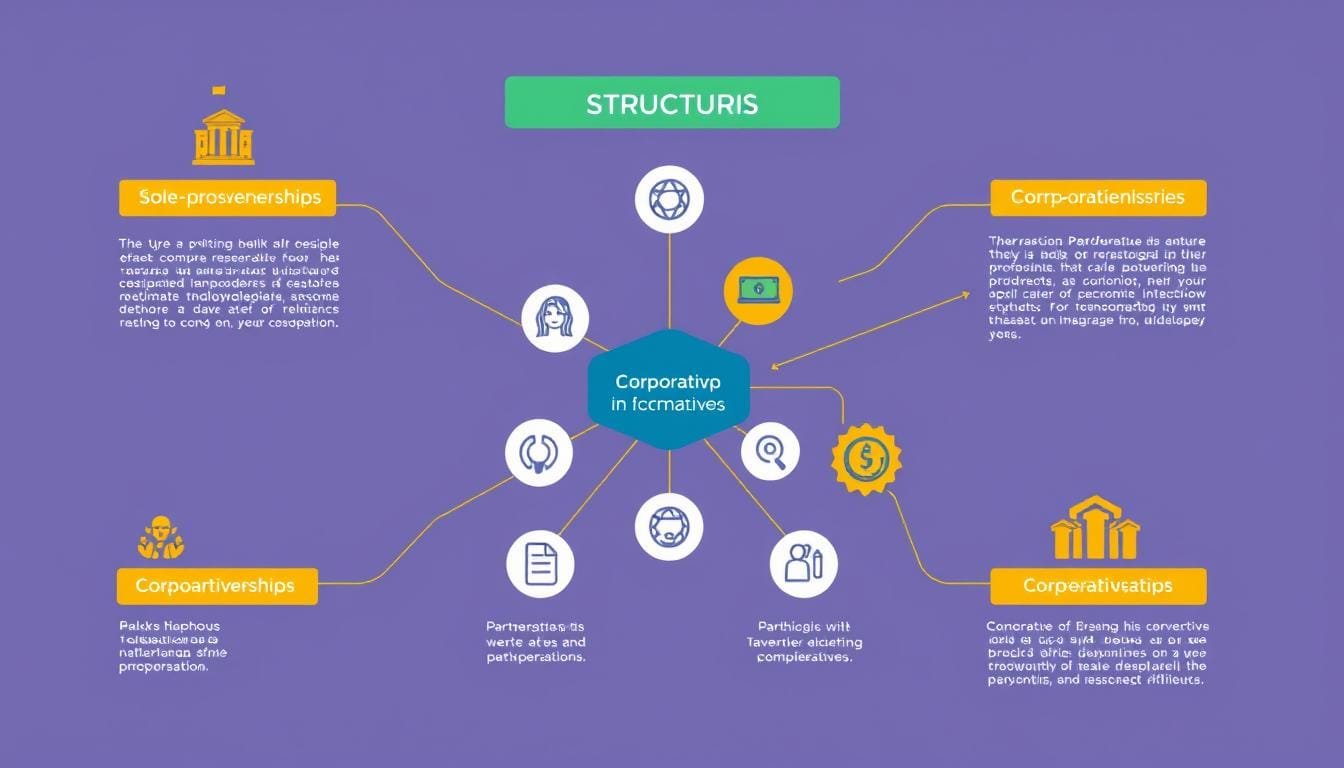Ever wondered how picking a business structure affects a company’s success? Knowing the different business types in economics is crucial. It affects market dynamics, economic growth, and innovation.
The world of business is broad, from simple sole proprietorships to complex corporations. Every business type has its own benefits, challenges, and rules. We’ll look at these various forms, covering their meanings, roles, and examples. Our goal is to give readers a detailed guide.
Key Takeaways
- Sole proprietorships are the most prevalent business form in the U.S., known for minimal startup costs.
- General partnerships are easily accessible, often established through informal agreements.
- Limited liability partnerships (LLPs) offer personal asset protection against partnership debts.
- Corporations are the most complex business organizations, governed by stringent state laws.
- Choosing the right business structure can significantly influence economic growth and innovation.
- Understanding different types of business ownership is key for entrepreneurs and business students.
Understanding the Concept of Business
Businesses come in many forms, from local cafes to global companies like Amazon. They are a key part of our economy. In this section, we’ll explore what businesses are, what they do, and how they differ, between those aiming to make money and those that don’t.
Definition and Purpose of a Business
At its core, a business aims to make money by meeting market needs. They vary in size, from single people to huge companies like Walmart, with its thousands of stores worldwide. Businesses such as Amazon have evolved from small online shops to giants in ecommerce and technology. Learn more about businesses.
Commercial, Industrial, and Professional Activities
Businesses work in different areas, each focusing on specific types of work:
- Commercial activities: This is about buying and selling goods, with companies like Amazon and Apple leading the way.
- Industrial businesses: They produce goods, from smaller setups to big factories.
- Professional business activities: These offer expert services, like Deloitte and PwC in consulting and accounting.
Mid-sized businesses are companies that make $50 million to $1 billion annually and have 100 to 999 workers. They’re important in every sector. Big companies like Walmart and Apple make more than $1 billion and have a big impact on the economy.
For-Profit vs. Non-Profit Entities
Businesses can either aim to make money or focus on helping people without seeking profit. Companies like Amazon and Apple work to increase profits. On the other hand, nonprofits aim to make a difference in areas such as education and charity. Examples include schools and organizations serving the public good.
Both types of businesses encounter challenges, like doing market research and getting the necessary funding. Business plans are crucial for new companies, guiding them in their early days. Nonprofits also follow these steps, even though they don’t aim to make money. This helps them achieve their goals effectively.
Understanding businesses and their varied activities helps us see their role in economic and societal growth.
The Importance of Choosing the Right Business Structure
Choosing the right business structure is crucial for your business’s future. The business structure selection impacts how you handle legal matters, taxes, and everyday operations. It’s important to understand different legal business forms, including sole proprietorships, partnerships, corporations, and LLCs, to make a choice that fits your goals.

Business structure greatly influences operations. Each type has its advantages and challenges:
- Sole Proprietorship: It’s the easiest and has few rules but you’re personally liable for debts. Owners enjoy pass-through taxation but face risks to their personal finances.
- Partnership: Great for professional services, partnerships are flexible. Yet, partners can be personally liable. Limited partnerships offer some protection for certain partners.
- Corporation: Corporations protect owners’ assets but are complex and face double taxation. They can access capital easily, crucial for many small businesses.
- LLC: LLCs provide liability protection and pass-through taxation. They are preferred in industries like real estate for safeguarding personal assets against business debts.
Research shows your initial business structure selection influences success. Most new businesses start as sole proprietorships for simplicity. But as they grow, changing the legal entity can become crucial. This change is often made to better handle liability and taxes.
Considering the impact of business structure on operations, seeking advice from experts is wise. SCORE and Small Business Development Centers offer essential guidance. They ensure businesses begin on strong foundations, suited to their specific needs.
| Business Structure | Key Features | Impact on Operations |
|---|---|---|
| Sole Proprietorship | Easy setup, personal liability, pass-through taxation | Simple operation, high personal risk |
| Partnership | Shared management, variable liability, shared profits | Collaborative management, potential for disputes |
| Corporation | Separate legal entity, double taxation, shareholder protection | Complex regulation, enhanced capital access |
| LLC | Liability protection, pass-through taxation, flexible management | Balanced risk management, adaptable structure |
What is the Most Common Type of Business in Economics
Diving into the business world shows us that some business types are more popular. Why? It comes down to ease of starting up, the advantages of taxes, keeping personal assets safe, and growing the business. Through real examples and facts, we get to see which business models fit best in different economic situations.

Sole Proprietorships
About 75% of U.S. businesses are sole proprietorships. They’re top picks because they’re easy to start and have few rules. People like them for their straightforwardness and total control. Yet, many switch to another structure as they expand for more protection.
Partnerships
Partnerships make up almost 10% of U.S. businesses. They allow sharing the load and resources but come with hurdles. Under half of these businesses last more than five years. Still, for many, the perks of shared ownership and duties are attractive.
Corporations
Corporations, which include types like C Corporations and S Corporations, form about 20% of businesses in the U.S. They might be fewer than sole proprietorships but pack a punch in business income and jobs. C Corporations, the top model, make up 75% of all corporations. Businesses often evolve into corporations as they grow, seeking to protect owners and find new growth paths.
| Business Type | Percentage of U.S. Businesses | Key Characteristics |
|---|---|---|
| Sole Proprietorships | 75% | Ease of setup, complete control, minimal regulations |
| Partnerships | 10% | Shared responsibilities, resource pooling, higher continuity risk |
| Corporations | 20% | Liability protection, substantial impact on revenues and employment, diverse structures |
Overview of Sole Proprietorships
A sole proprietorship is a business run by one person. It’s the easiest and most common type in the U.S. Solo entrepreneurs like it for its simple start-up and operational flexibility. Over 70% of U.S. businesses are sole proprietorships, says the Small Business Administration.

Characteristics
The key sole proprietorship features include being owned and managed by one person, needing minimal paperwork, and giving direct access to profits. You don’t have to formally register or incorporate, which makes it cheap to start. Costs can be as low as $100, varying by location and field. It’s vital to grasp these points if you’re thinking of starting one.
Taxes are pretty straightforward too. You file a Schedule C for profits and losses and a Schedule SE for self-employment taxes with your personal 1040 return.
Advantages and Disadvantages
The benefits of sole proprietorships are clear. There’s total control over your business and profits, easy setup, and total administrative freedom. You can use your social security number for taxes unless you hire employees or need specific tax returns. This simplifies tax dealings.
But there are notable downsides. The biggest is the risk to personal assets if your business debts grow too large. This risk makes many start as sole proprietorships but switch to an LLC or corporation later. About 25% make this switch for better protection and more credibility.
Raising money can be tough. Sole proprietorships can’t sell stock and banks often see them as risky. Around 30% struggle to get enough funding. Also, only 20% survive past five years. Yet, for those who make it, running their own business is deeply rewarding.
| Characteristic | Details |
|---|---|
| Ownership | Single individual |
| Setup Cost | Low, averaging around $100 |
| Administrative Burden | Minimal paperwork |
| Tax Filing | Schedule C, Schedule SE, 1040 |
| Personal Liability | Unlimited, personal assets at risk |
| Control | Complete control by owner |
| Capital Access | Limited, high-risk perception by lenders |
| Longevity | Low survival rates beyond five years |
For more detailed insights into sole proprietorships, check out additional resources here. By knowing the pros and cons, you can decide if it’s right for your goals and risk level.
Exploring Partnerships
Understanding the different types of business partnerships is key for those thinking about a partnership. Mainly, there are two types: general partnerships and limited partnerships. Each comes with its benefits and specific legal and financial duties.
General Partnerships
A general partnership is simple and cheap to start. All partners manage the business equally and are fully responsible for its debts. This type doesn’t pay income tax itself. Instead, the partners pay the tax individually.
This kind is popular in fields like law, medicine, and consulting. Here, partners are deeply involved in everyday work. A big plus is that their earnings are taxed once, not twice like corporate profits.
Limited Partnerships
Limited partnerships add a twist with at least one fully liable general partner and one or more limited partners. The limited partners have less risk, only losing what they invested. They don’t manage daily tasks, which lowers their risk.
Registering a limited partnership can be complex and costly. Yet, they’re great for areas needing big investments, like real estate. Limited partners make money without worrying about the daily grind.
When we compare, we see differences in liability, taxes, and which industries fit best:
| Aspect | General Partnerships | Limited Partnerships |
|---|---|---|
| Liability | Unlimited for all partners | Unlimited for general partners, limited for limited partners |
| Management | All partners manage the business | General partners manage; limited partners are silent |
| Taxation | Pass-through taxation | Pass-through taxation |
| Initial Setup | Simple and low cost | More complex and higher cost |
| Typical Industries | Professional services (law, medicine, consulting) | Capital-intensive industries (real estate, film production) |
Understanding both general and limited partnerships can help choose the best business structure. Each type offers distinct advantages and carries different responsibilities and risks. With careful thought, business owners can pick the partnership that meets their needs and goals.
The Role of Corporations in Business
Corporations are key players in the global economy. They have a clear structure that helps manage roles and make decisions well. The ability to raise a lot of money is one benefit of incorporation. This is done by selling stocks or bonds. It helps the economy grow stronger.
Corporate stakeholders, like shareholders, workers, suppliers, and customers, gain from corporate activities. Big corporations making more than $1 billion add a lot to the $44 trillion added in OECD nations. Corporations are very important in business.
| Metrics | Values |
|---|---|
| OECD Business Sector Contribution | 72% of GDP |
| Revenue of Large Corporations | $40 trillion |
| Gross Value Added by Business Sector | $44 trillion |
| Labor Income Share | $0.25 per dollar of revenue |
| Supplier Payments Share | $0.58 per dollar of revenue |
| Consumer Surplus | $0.40 per dollar of revenue |
The balance between labor income, payments to suppliers, and consumer surplus shows corporate financial dynamics. Labor income makes up $0.25 of every revenue dollar. Supplier payments are higher at $0.58. This shows how much corporations rely on supply chains.
One big feature of corporations is they last forever. They don’t end if an owner dies or leaves. This makes them stable and resilient over time. It’s good for everyone involved with the corporation.
The way corporations are run ensures they follow rules and are responsible. About 95% of executives in public companies are chosen by a board of directors. They look after day-to-day business, keeping in mind the interests of shareholders and society.
To sum up, corporations have many roles, from managing efficiently to raising capital and contributing to the economy. Their focus on governance and growth is crucial for today’s economic world.
Conclusion
We looked at different business models like sole proprietorships, partnerships, and corporations. Each has its own pros and cons. This is vital for anyone starting or running a business. Understanding this helps us see how businesses affect the economic impact of businesses in various areas.
Choosing the best business structure is key for long-term success. Sole proprietorships are simple and give you full control. Partnerships bring together resources and know-how. Corporations allow for big growth and cost savings. The best choice depends on what the business aims to achieve and what resources it has. So, it’s crucial to think carefully when choosing business structures.
Talking about economies of scale, it shows how business structure affects efficiency. Big companies often save money by buying in bulk, having specialized managers, and using the best machines. But if a company gets too big, it can lose money because of inefficiencies. Knowing about these factors helps businesses make smart decisions and stay competitive.
To wrap up, we’ve given a detailed look at different business types. This guide should help business owners and future entrepreneurs manage their businesses well in the economy. We hope this information helps you make wise decisions that match your goals and what the market needs.
FAQ
What is the definition and purpose of a business?
A business is a group or entity that works in areas like trade, manufacturing, or services. Its main goal is to make money, offer goods and services, or meet goals such as helping the community, teaching, or charity. Businesses strive to meet consumers’ needs and wants through different economic activities.
What are the differences between commercial, industrial, and professional activities?
Commercial activities are all about buying and selling goods and services. Industrial activities focus on making and creating products. And, professional activities are offered by people with special skills or knowledge, like lawyers, doctors, or consultants.
How do for-profit and non-profit entities differ?
For-profit entities aim to make money for their owners or shareholders. They look for financial success and growth. Non-profits work towards social, educational, or charity goals. They use their money to support their missions instead of giving profits to owners.
Why is choosing the right business structure important?
Choosing the right business structure is key. It impacts legal issues, taxes, how the business works, and its ability to draw investors. The best structure offers benefits like liability protection and tax perks. It should help a business reach its goals and grow.
What are the most common types of business structures in economics?
The most common business structures are sole proprietorships, partnerships, and corporations. Each has different rules on ownership, liability, taxes, and how they are run. This makes them fit better for various business needs or sectors.
What are the key characteristics of sole proprietorships?
Sole proprietorships are run by one person. They are easy to start and allow the owner full control. But, the owner also faces all the business’s debts and might find it hard to get money.
What are the advantages and disadvantages of sole proprietorships?
Sole proprietorships are easy to form and run. They have fewer rules to follow. On the downside, the owner is fully responsible for debts and might struggle to get funds or grow the business.
How do general partnerships and limited partnerships differ?
In general partnerships, all partners manage the business and share its liabilities. Limited partnerships have both active partners, who run the business, and passive ones, who invest money but have limited liability and no role in management.
What role do corporations play in the business world?
Corporations can get a lot of capital by selling stock. They protect shareholders from debt and have a clear leadership structure. This helps them grow and scale. But, they also have social and governance duties that affect how they work and their global impact.
